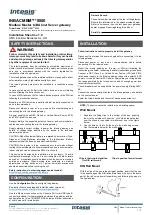
Manual Version 3.21
Page. 7 of 73
SECTION 3 - OUTLINE OF JX-10 FUNCTIONS
The JX-10 features functions that are quite different from those of older synthesizers. Therefore, it is very important
to understand these functions. Read the following explanations, then go to
“
SECTION 4 - OPERATION
”
.
3.1
The JX-10 stores 100 different sounds (
Tones
) – 50 of them can be rewritten, the other 50 are
non-volatile. There are 64 combinations of Tones and various performance control functions (this
combination is called
Patch Memory
). That is, a Patch Memory consists of a Tone or a pair of
Tones and performance control functions which we call
Factors
in this manual. Normally, to
change sounds during a live performance, you would select a different Patch Memory.
(See page 10 “Selecting a Patch Memory”)
3.2
The Factors of a Patch Memory can be edited easily whenever you want.
(See page 17 “Editing a Patch Memory”)
3.3
The Tone of a Patch Memory can be edited just like you would on a normal synthesizer, A tone
consists of various parameters and a tone is edited by changing these parameters.
(See page 20 “Editing a Tone”)
3.4
To write the edited Patch Memory into the JX-10’s memory, follow the appropriate WRITE
procedure.
(See page 30 “Writing a Patch Memory”)
3.5
Using a Memory Cartridge (M-64C), the following data transfer is possible:
a) Saving of each Patch Memory/Tone to the memory cartridge and loading it back to the JX-10.
b) Saving the entire data (50 Tones and 64 Patch Memories) on the JX-10 to the memory
cartridge and loading it back to the JX-10.
(See page 35 “Memory Cartridge”)
3.6
Note that with the new firmware, the Sequencer (supplied as standard in the original unmodified
JX-10) is not present any more.
This has been replaced with a programmable 8 memory arpeggiator.
(See page 29 “Arpeggiator”)
3.7
All the Patch Memories and Tones can have their own unique names which can be changed as
necessary.
(See page 32 “Naming a Patch Memory”)
3.8
The JX-10 features MIDI functions necessary for operating with or being operated by, other MIDI
devices. The MIDI functions can be changed according to your requirements.
(See page 41 “MIDI”)
3.9
To make the above operations quicker and easier, the JX-10 has a display window. If you perform
an incorrect operation, the display will respond with an appropriate error message.
(See page 40 “Error Messages”)








































